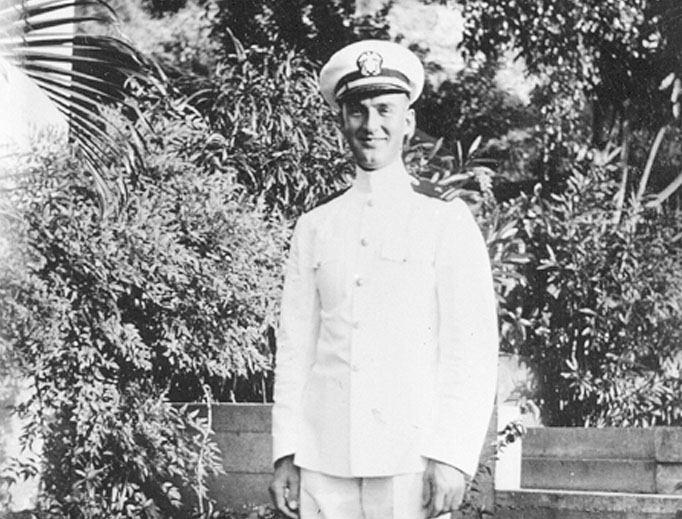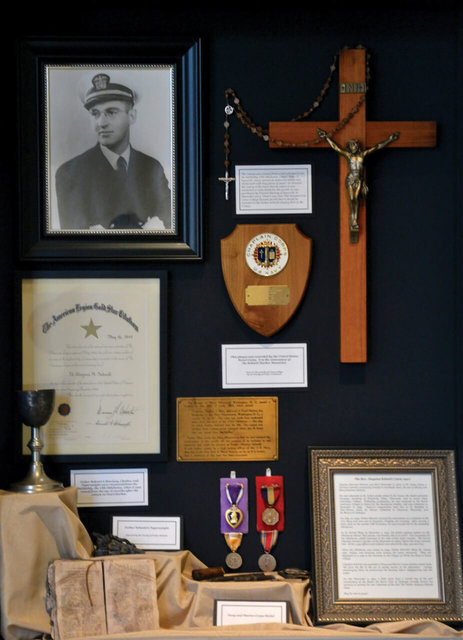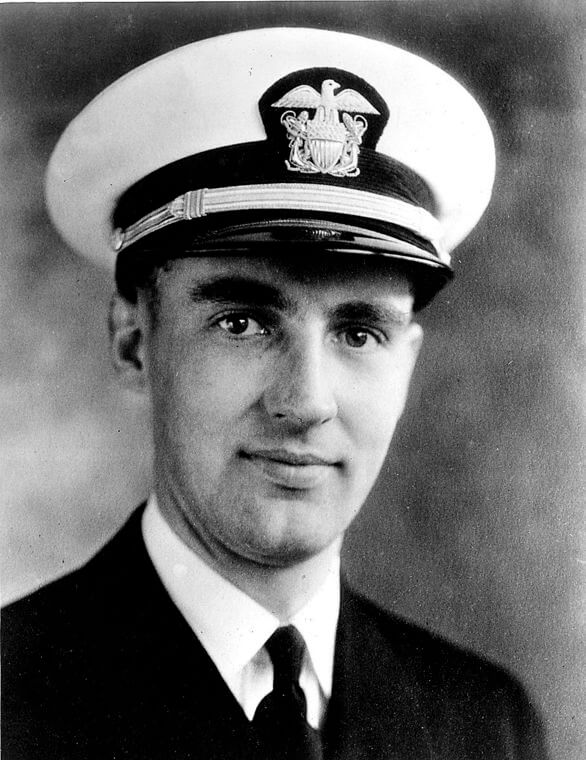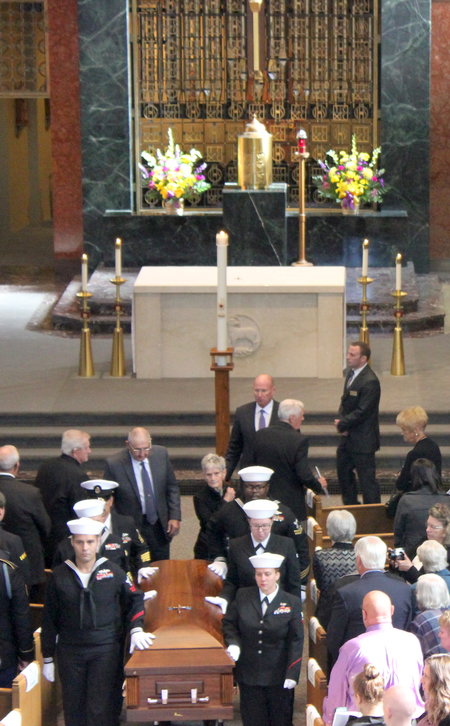Pearl Harbor Priest Identified 75 Years Later
Father Aloysius Schmitt was the first chaplain to die in World War II.

DUBUQUE, Iowa — When Archbishop Michael Jackels lifted the chalice during the consecration at a memorial Mass on Oct. 8 in Dubuque, Iowa, many hearts were filled with emotion.
It was the first time this chalice had been used since the 7am Mass aboard the battleship USS Oklahoma docked in Pearl Harbor on Dec. 7, 1941.
The chalice belonged to Navy chaplain Father Aloysius Schmitt. The Mass at Christ the King Chapel at Loras College was being held in memory of this heroic chaplain, who died saving others during the attack on Pearl Harbor.

After 75 years, his remains were finally identified this year and brought back to Iowa for burial in Christ the King Chapel.

“It was an amazing gift to receive from that chalice,” said concelebrant Father Daniel Mode, director of plans and operations for the Chief of Chaplains Office of the Navy. “That chalice was found 16-18 months later, when they raised the Oklahoma from Pearl Harbor.”
Father Mode, the author of The Grunt Padre about Servant of God Father Vincent Robert Capodanno, spotted the sacred vessel in the case at Christ the King Chapel displaying Father Schmitt’s effects before the memorial Mass and asked if it could be used.
“That actually set the tone for the service,” said Father Schmitt’s grandnephew Steve Sloan. After the Mass, the casket with Father Schmitt’s remains was taken outside for full military honors and then interred in the chapel, which was built in 1946-47 and dedicated to him. No one has ever forgotten what their graduate and Iowa’s native son did that Dec. 7 so long ago.
75 Years Ago
Father Schmitt had just finished celebrating the 7am Mass when the first wave of Japanese planes swooped into the harbor at 7:48am. They hit the Oklahoma with eight torpedoes, then later a ninth. The commanding officer reported the initial five explosions happened within about 70 seconds — and within eight to 10 minutes, the ship rapidly rolled over about 135 degrees.
During those frantic minutes, as men scrambled to escape the capsizing ship, 32-year-old Father Schmitt began pushing men through a small porthole to safety. One was sailor Bob Burns.
Interviewed years ago for a documentary called For God and Country, Burns vividly remembered that Father Schmitt “recognized my voice and said, ‘Over here!’ There were two gentleman topside pulling, and he was pushing people through — he pushed me out.” Burns had served at Mass that morning.
“He was one of the finest men I had ever known,” Burns said of the chaplain. “It was an honor knowing him.”
Once Chaplain Schmitt got the 12 out safely, the dozen men tried pulling him through the porthole. He was partly through when he heard men behind him and insisted the freed men push him back into the ship so that he could help the trapped men.
He never got out.
The heroic priest was among 429 sailors and Marines who died aboard the Oklahoma — one of the two ships losing the most men at Pearl Harbor. He was also the first Catholic chaplain — in fact, the first of any chaplain — to die in World War II.
Now, in time for the 75th anniversary of Pearl Harbor, he came home to where he grew up and where he has never been forgotten.
Hometown Priest
On Oct. 5, Father Schmitt’s flag-draped coffin arrived for a memorial Mass at his home parish, St. Luke Church in St. Lucas, a two-hour drive from Dubuque.
Born on Dec. 4, 1909, he grew up the youngest of 10 children in a farm family in the rural community and attended Catholic schools. After graduating from Loras College, then called Columbia College, he studied for the priesthood in Rome and was ordained on the Solemnity of the Immaculate Conception, Dec. 8, 1935. In 1939, his archbishop permitted him to enlist as a Navy chaplain.
Father Schmitt’s nephew Del Schmitt, now 82 years old, was only 5 the last time he saw his uncle. “It was hard on my dad and the family,” he said, when they learned of the death of “Father Al,” as he was affectionately known. “People that knew him said he was a great guy. Everybody liked him. Now, there’s satisfaction they did bring him back.”
Schmitt and his brother and sister presented “the gifts for the Mass,” he said of the special Mass.
Another lifelong St. Luke parishioner, Leander Stammeyer, led the Rosary at the Oct. 8 Mass and also prayed an Our Father and Hail Mary in German “to show how he [Father Al] learned the Rosary at his mother’s knee.”
Stammeyer, a spry 95-year-old, remembers Father Schmitt well. “I served at his first Mass when he was ordained,” he said. “I played checkers with him when I was a little boy, and he was 10 years older than me.”
During vacations from school, Stammeyer stayed with his grandmother in St. Lucas, and Father Al was home from college. His grandmother told him to play checkers with Father Al in the evening. They would play for at least two hours.
“I always looked up to him. He gave a good example,” Stammeyer recalled. Stammeyer himself went to seminary in Milwaukee before going “into the service because Uncle Sam called me.” He entered the Navy in 1942.

Another Generation
Sloan, himself a graduate of Loras, never met his great-uncle, but heard much about him from the family.
“I was fortunate enough to know the sister that was closest to him age-wise — Sister Germaine Schmitt — who was a Franciscan sister and would spend holidays with us growing up,” Sloan explained. “Not a holiday passed when we didn’t have a discussion about Father Al in our household. It was a common discussion.”
Sloan recalled how Sister Germaine would always say, “We knew what he did, but when he left that porthole and said, ‘I’m going to check on some other men and bless them,’ we don’t know what happened to him.”
Sloan added, “I look forward to the day when I have the opportunity to talk to Father Al and ask him what really did happen that day.”
Finally an Identification
Work on the ship after the attack uncovered the remains of the 429 killed on the Oklahoma, but only a small number could be identified. Attempts over the years failed to identify about 388 men. They were reburied in Honolulu in 1950. Then came DNA identification and the U.S. Department of Defense’s determination to return as many as possible to their families.
Sloan explained that a forensic genealogist working for the department used mitochondrial DNA, a stronger form from the female side of the family tree, for the identification. In September, military representatives came to Iowa to tell relatives that they identified Father Schmitt’s remains. The Sloans were overjoyed.
This was not the first time the Navy had come to town. In 1944, the Navy presented the Archdiocese of Dubuque with a 24-inch-tall crucifix made from the Oklahoma’s teakwood deck, with the corpus of Christ shaped from the ship’s metal in honor of Chaplain Schmitt.
The Witness, the Catholic weekly in Dubuque, carried a Dec. 14, 1944, front-page article on the presentation by the chief of chaplains, 8th Naval district, who recalled Father Al’s “zeal in the service of others, coupled with a sincere and winning personality.” Mentioning his college motto — Pro Deo et Patria (“For God and Country”) — he added, “When he realized the hour had come for him to follow in the footsteps of his Master, he might well hold his head high, as he went forward a worthy bearer of the motto of the alma mater.”
Continuous Remembrance
When Christ the King Chapel was dedicated in Father Schmitt’s honor in 1947, both Cardinal Samuel Stritch of Chicago and Admiral Chester Nimitz, commander of the U.S. Pacific Fleet during World War II, were there.
A display added in the chapel contains several of Father Schmitt’s personal effects that were recovered from the Oklahoma, plus other items like his medals and a rosary made from the ship’s wood. The personal items include his chalice and prayer book; the ribbon, still in place, held in place prayers for the following day, Dec. 8, which would have been the sixth anniversary of his ordination.
As a Loras undergraduate walking into the chapel, Father Kyle Digmann always saw those mementos. Today, he is pastor of Christ Our Hope Cluster of parishes, which includes St. Luke’s. “Everybody knows about Father S. He is part of the history around here.”
And that history was made more poignant with the memorial Mass.
“It was indeed an honor to represent the chaplain corps at that funeral,” Father Mode said while looking at a photo of himself by Father Al’s casket.

“It truly made me realize the sacrifice that he made 75 years ago never dissipated. It’s linked to Christ’s sacrifice; it’s eternal. Even 75 years later, it has the same awe. That was an amazing witness, not only to what Chaplain Schmitt was, but the essence of what sacrifice is.”
Archbishop Timothy Broglio, head of the Archdiocese for the Military Services, concelebrated the memorial Mass. He told the Register that Father Schmitt’s witness continues to reverberate: “The burial of the earthly remains of Father Al Schmitt, whose heroism is so typical of Catholic chaplains’ commitment to be men for others, reminds us of his valor immediately after the attack on Pearl Harbor 75 years ago. Just like the Lord, whom he loved and served, Father Schmitt gave up his life, so that others might live. I pray that his selflessness might inspire all people to imitate his concern for others and his commitment to life.”
Joseph Pronechen is a Register staff writer.
INFORMATION
For God and Country DVD is available from the Dubuque Archdiocese’s educational resource center, (563) 556-2580 or (800) 876-3546.
















